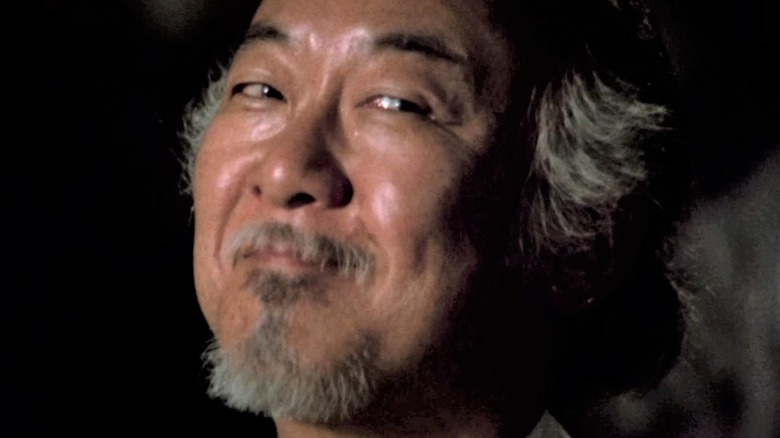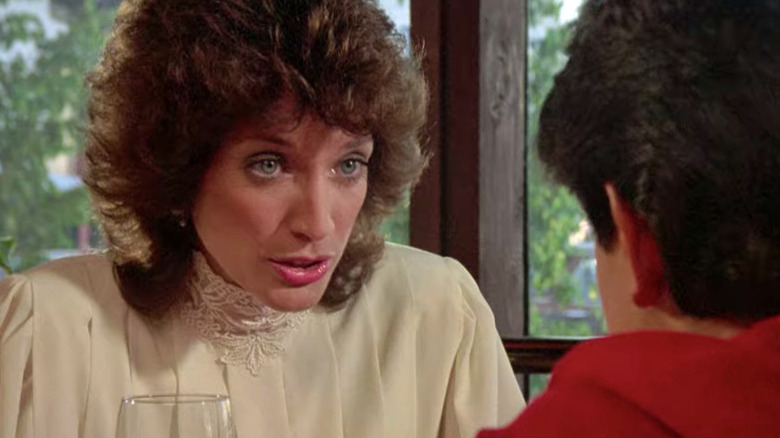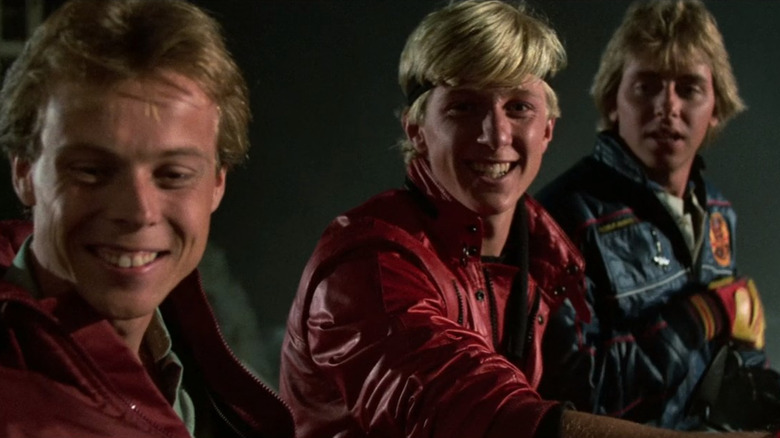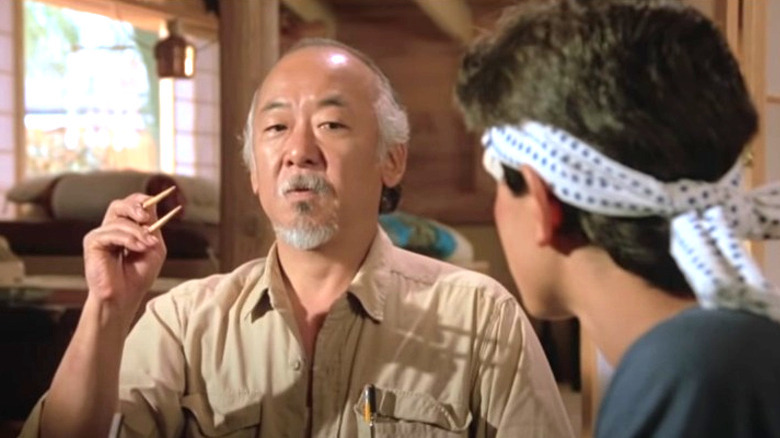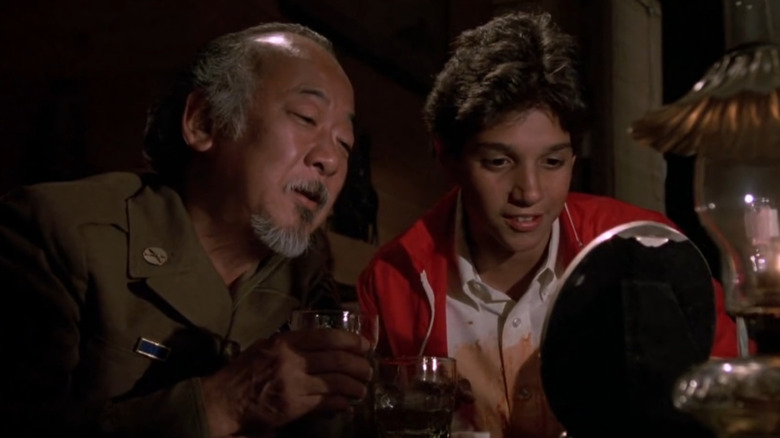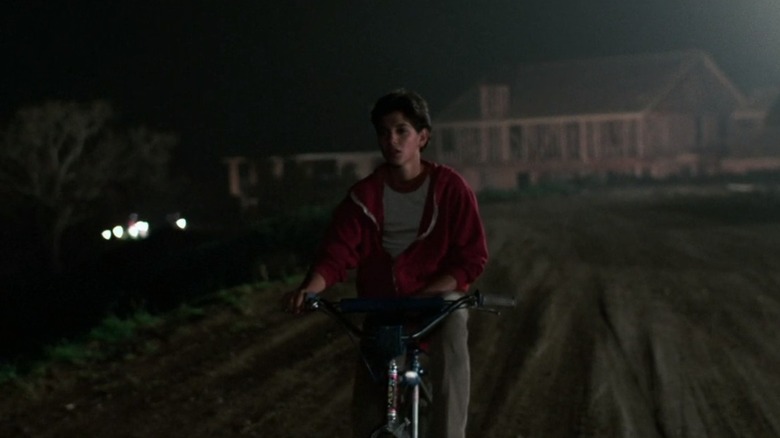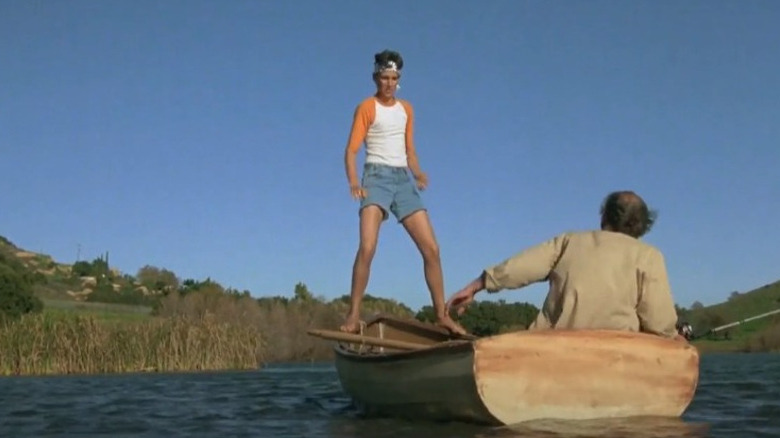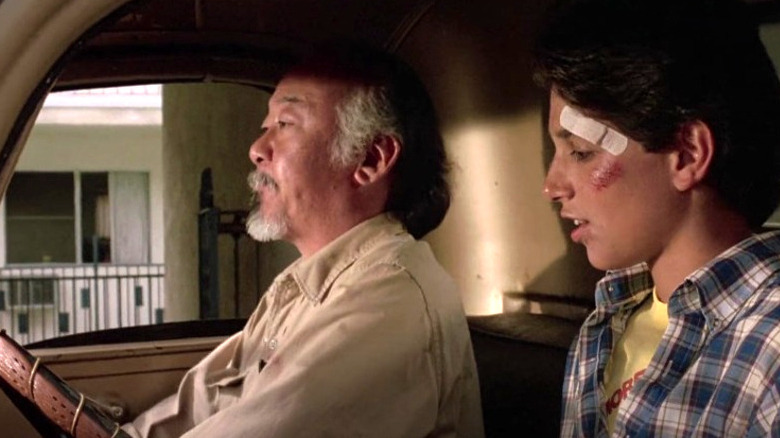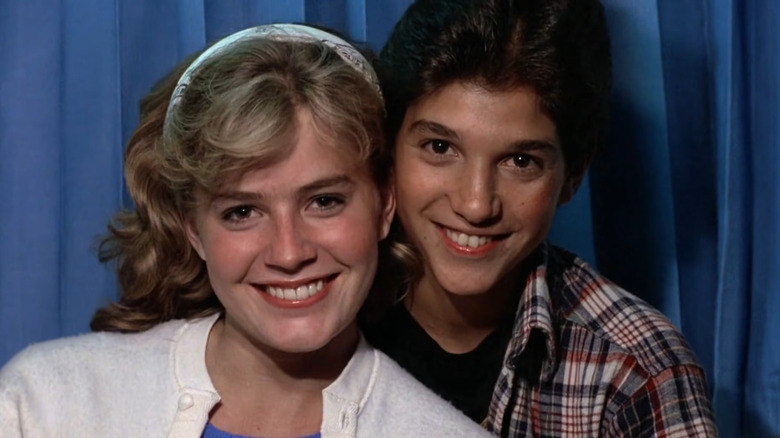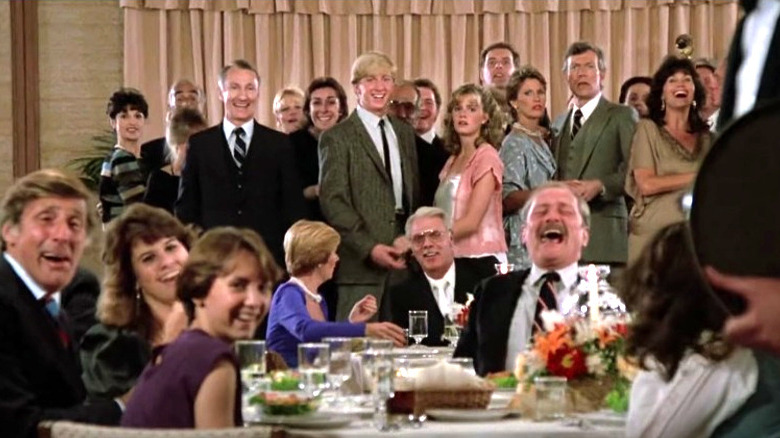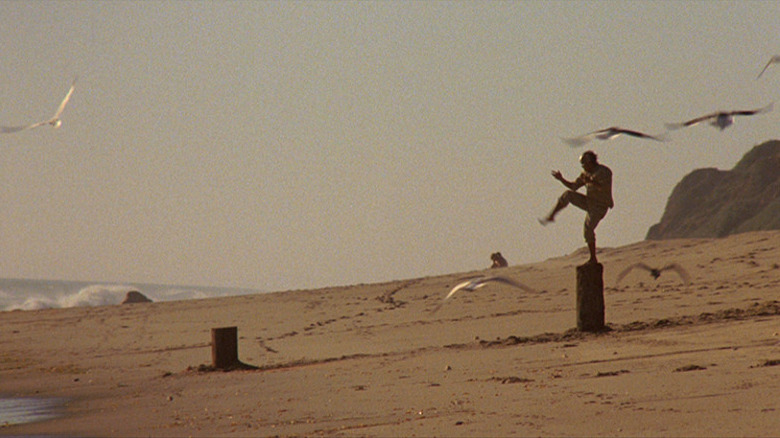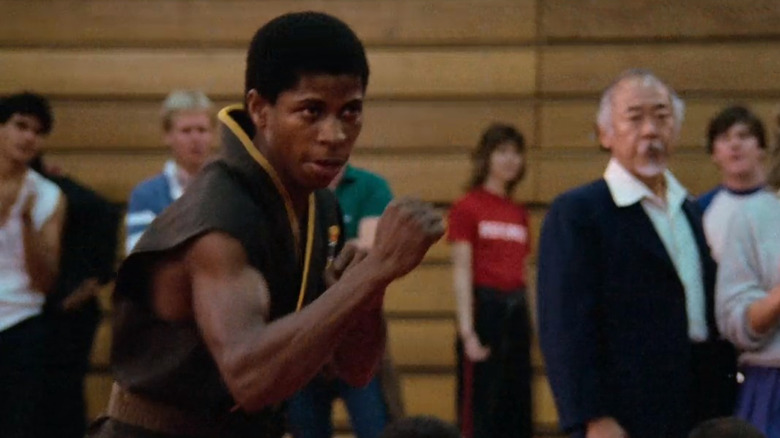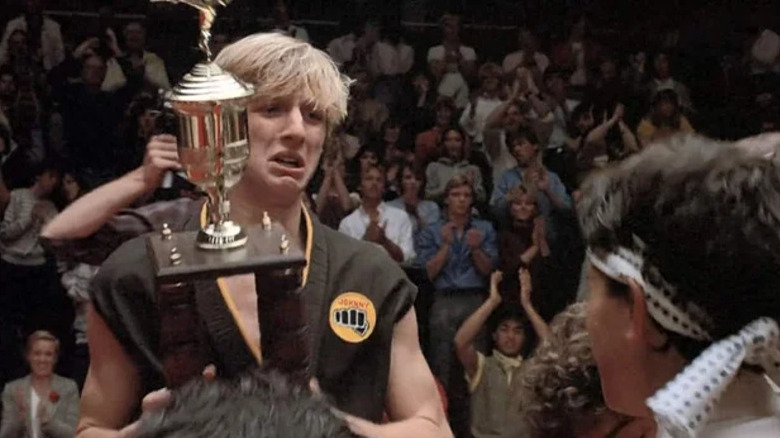6 Best And 6 Worst Things In The Karate Kid
Released in 1984, "The Karate Kid" was such a massive hit that it spawned three sequels, a reboot, and sequel series "Cobra Kai," which focused on the original film's main antagonist. It's a timeless story about a young man from New Jersey named Daniel LaRusso who stands up for himself against the entitled bullies who are making his new life in California miserable. With the help of his building's maintenance man — who knows a lot about karate — Daniel wins a martial arts tournament, gains confidence in himself, and earns the respect of those who would otherwise treat him like dirt.
While much of the film still holds up almost four decades later, there are a few elements that haven't aged quite so well. Some of these have only become clear with hindsight, while others were issues from the get-go that most audience members chose to forgive because the rest of the film was so great. At the same time, many elements of the film deserve praise for working just as well today as they did in 1984. So join us as we take a balanced trip down memory lane and look at the best and worst things about "The Karate Kid."
Worst: Underutilizing Randee Heller
The film begins with Daniel and his mother Lucille making the move across the country to California. It's obvious from the start that she is far more into the idea than he is. When they finally arrive, she looks relieved and excited, and Daniel appears deeply disappointed. This sets up their relationship perfectly. Lucille is the more optimistic of the two, even if she is just getting a job in a restaurant.
Usually, the parent in this situation would be portrayed as an antagonist, always arguing with her son, demanding he gets his act together and stops moping. Lucille is much kinder, more patient, and more supportive than that. Although this could be down to the writing, Randee Heller's performance is what brings it to life. Instead of a one-dimensional side character, Lucille is a living, breathing person with a complex inner life that we can only glimpse through Heller's body language, facial expressions, and tone.
Unfortunately, she leaves the movie at some point. True, Daniel and Mr. Miyagi's relationship is the core of the movie, but it would have been nice to include Lucille a bit more. Heller is fantastic in every scene and is sorely missed when her character vanishes only to come back for the end. Shoving her aside doesn't destroy the movie by any means, but it is noticeable when she's no longer around.
Best: Johnny Lawrence's intro
In the film, as in life, you only get one chance at a first impression. This is why it's critical that you introduce your characters in such a way that the audience gets it immediately. With Daniel, we see that he's a young guy in a situation he didn't ask for. Mr. Miyagi is a quiet man with hidden depths. Then there's Johnny Lawrence. Within seconds of meeting him, we know what a jerk he is.
We know this because he is introduced just as everything seems to be going well for Daniel. Our protagonist is at the beach with some locals who seem to like him. He meets a girl named Ali who really seems to like him, and he's probably thinking, "Maybe California won't be so bad." We then cut to a group of guys in leather jackets on motorcycles cruising towards the beach. The second you see the cloud of dust their bikes are kicking up, you know they mean trouble.
Johnny looks like the cocky, self-involved bully he is. To further demonstrate this, the second he sees Daniel with Ali, his demeanor changes, and we see the rage boiling just below the surface. Not only is this excellent visual storytelling, it perfectly sets up Johnny's arc, from narcissistic psycho to someone who eventually respects Daniel.
Worst: Those poor flies
From wax on-wax off to the crane kick, there are a lot of iconic scenes in "The Karate Kid." A moment in which Mr. Miyagi explains to Daniel that a man who can catch a fly with chopsticks can do anything is one of those scenes. Not only does it prove that Daniel really can do anything (like win a karate tournament with a busted leg) but it's an excellent piece of filmmaking and acting as it is just two actors sitting together, focusing on the same task with different results.
Unfortunately, though, a lot of flies had to die to make the scene work. Today, the fly would probably be computer-generated, but back in the early 1980s, they had to use the real thing. While being interviewed on "The Tonight Show," Daniel LaRusso actor Ralph Macchio discussed the different attempts to film Daniel capturing the fly. They ranged from surprisingly complicated to gravely simple. At one point, they captured real flies and tied a fishing line around them. When Macchio attempted to catch them, it was instant death for the decapitated insects. Your opinion may vary, but for some, knowing that really puts a damper on a great scene, and the film would've been better off if no flies were sacrificed.
Best: Pat Morita's performance
It's hard to imagine anyone else other than Pat Morita in the role of Mr. Miyagi. Primarily known for comedic roles such as Arnold on "Happy Days," Morita wasn't even considered for the part originally. When talking to the Archive of American Television, Morita explained that producer Jerry Weintraub didn't want any comedic actors because the role required such gravitas.
After struggling to find an actor who could fit the bill, the filmmakers eventually brought Morita in. He had to come back five times, but the role of Miyagi was finally awarded to him. The part is deceptively simple, and Morita is superb. He knows exactly what each scene calls for, and he delivers. He can obviously handle the comedy with ease, but the dramatic moments are wonderfully underplayed and subtle. We're always aware that Miyagi's thoughts are somewhere, but his stoicism betrays nothing.
So, when he unleashes an outburst of anger, we're thrown to the back of our chairs. If he cracks a joke, we lose it. When his calm facade cracks for heartbreak to pass through, we feel that too. The movie probably could have worked without Morita, but it certainly wouldn't have become the stone-cold classic it is today.
Worst: Falling down the hill
The filmmaking in "The Karate Kid" ranges from naturalistic to cinematic. Most of the scenes involving everyday life tend to be executed in a plain, straightforward style that grounds the whole thing in a believable time and place. Many of the training scenes are treated more stylistically. One scene that would have benefited from a less realistic and more stylized approach is the one in which Daniel rolls down a hill.
He's out riding his bike at night when the bullies show up and drive him off the path. It's an important scene because it leads to the moment where he finally breaks down and tells his mother what's been going on, and he admits that he hates living here ... but the cinematography is awkward. From a low angle, we look up and watch as Daniel cascades down the hill and is "thrown" from his bike. While Ralph Macchio is excellent at making us believe he can really do karate, this stunt double doesn't sell the fall at all. For one thing, the hill doesn't look all that steep, and there doesn't appear to be anything in the bike's away that would cause the rider to go flying. Instead, it looks like Daniel simply decides to somersault off of his bike for no reason. Again, it's an important scene, but the mechanics of it take you right out of the moment.
Best: Balance training
The more stylized form of storytelling in "The Karate Kid" is primarily reserved for the training scenes. Whether it's Daniel sanding the deck or painting the fence around Mr. Miyagi's garden, the camera work becomes more fluid the more Daniel learns. The best examples of this are the scenes in which Mr. Miyagi tries to teach Daniel the importance of balance.
He takes Daniel to the beach and has him practice in the ocean. As monumental waves fill the frame, their enormous size dwarfs scrawny Daniel LaRusso. They crash into his lanky frame and knock him off his feet with ease. The task seems impossible until he turns and sees Mr. Miyagi balancing on a log with one leg. Then Miyagi takes Daniel out to a lake and has him practice his poses on the bow of a boat.
The grandeur of the lake is nothing compared to that of the ocean, but there is still an epic scope to this moment that opens up the film and brings it into all new territories. It mirrors the inner journey Daniel is taking. The deeper he dives into his own will, the bigger the world around him feels because he is opening his eyes to new possibilities instead of limiting himself to what he thinks he knows.
Worst: Miyagi's questionable decisions
Mr. Miyagi is clearly a wise man with a wealth of life experience to impart to his young pupil. Although he keeps to himself, there is much more to him than meets the eye. Of course, he doesn't always have the best judgment when it comes to helping Daniel sort out his problems.
The first indication of this is on Halloween. Daniel is surrounded by the Cobra Kai guys and mercilessly beaten. Just when things are at their worst, Mr. Miyagi shows up and knocks the snot out of them. It's an awesome moment that leads to Daniel's training, but it raises questions about Mr. Miyagi we would rather not be asking. Such questions include, is it okay for an adult to pummel high schoolers? Will they report this to the police? Why didn't he ask them to back off first? Sure, they'd refuse, but then he'd have a good reason for inflicting such pain.
Then there's allowing Daniel to drive even though neither of them have their license. Not only is that illegal but incredibly dangerous. Finally, as Miyagi gets drunk and mourns the death of his wife and child, he offers Daniel a drink. Yes, he wasn't in his right mind and Daniel's a responsible kid, but that's still not cool. These moments all serve an important dramatic purpose, but those questions run the risk of taking you out of the narrative.
Best: Daniel and Ali's Chemistry
A pessimist would say that Daniel's problems really started because of a girl. That's not to say that his life in California would have been without struggles had he not met Ali Mills, but he might have had more time to adjust before the Cobra Kai bullies decided to use him as a punching bag. An optimist would say that Daniel never would have found the strength to reach his full potential if he and Ali hadn't met.
The romance between Daniel and Ali works so well because they're both fully realized characters with agency and because actors Ralph Macchio and Elisabeth Shue are phenomenal together. At no point does their relationship come off as forced. These are clearly two great actors with an affection for one another (be it friendly or professional admiration) playing into that and sealing it for the audience. Had the chemistry not been there, the whole romance would have been useless. Since they have a rapport, the love story hits you right in the heart, and you can't help but root for them.
Worst: Johnny kissing Ali
Johnny Lawrence, as we said before, is not a nice person. We don't know a ton about him, but we can tell that he's not someone who is used to taking no as an answer. When he wants something, he doesn't ask — he takes. This can be a good thing if he wants something that is not only attainable but willing to go with him. It's when what he wants (in this case, a person) has no interest in him that this becomes a problem.
Considering this, it makes perfect sense that he would force himself on Ali. It's 100% within his character to do so. He's the villain, after all — we're not meant to like him. But he steps over the line big time when he assaults Ali by forcing a kiss on her to make Daniel jealous. It's such a repugnant character beat that, again, it raises questions we should not be asking. Will he be punished for this? Yeah, Ali slapped him, but will there be further consequences?
Speaking of the slap, Ali justifiably clocks him across the face before storming off. Her mother is confused by this and actually asks Johnny if he's okay rather than checking on her daughter. Everything about the scene feels wrong, unnecessary, and intrusive. There were probably other ways of convincing Daniel that something was going on between Johnny and Ali. At least "Cobra Kai" offered some closure regarding the scene and their relationship.
Best: The music
Prior to "The Karate Kid," director John G. Avildsen and composer Bill Conti worked together on the equally classic underdog story "Rocky" in 1976. While no score will ever be as instantly recognizable and iconic as Conti's anthem "Gonna Fly Now" — the one that plays during Rocky Balboa's training montage — "The Karate Kid" paves its own path to legendary status by being incredibly versatile. Much like Avildsen's direction, Conti's score swings from modern and simplified to grandiose and mythical.
Many of us may not be able to walk around whistling Conti's score to "The Karate Kid," but we all recognize it the moment we hear it. The music conjures a passion within our hearts to tap into our deepest wells of perseverance and make the impossible happen. The pop music serves a similar purpose as well. In certain scenes, it works like window dressing, just there to compliment what's going on. Then something like "Cruel Summer" by Bananarama or "You're the Best" by Joe Esposito kicks in, and you're drawn deeper into the world Avildsen has crafted.
For some, the needle drops might date the film. To those who grew up with it, though, they are a time machine to a thrilling time in life where everything seemed possible thanks to "The Karate Kid."
Worst: Lack of Diversity
There are those who will explain away the prevalence of white actors in "The Karate Kid" as being a consequence of when it was made. They will likely maintain that modern audiences cannot criticize a movie for reflecting the trends of the time. To a certain extent, this is understandable. However, when it comes to representation, this argument is worthless.
The film features non-white actors. Pat Morita is of Japanese descent. Larry B. Scott (who co-starred in "Revenge of the Nerds" that same year) is also in the film. There are a few other actors of color to be spotted throughout the movie, but none of them have prominent roles. Therefore, most of the parts awarded to non-white actors are relegated to the background or heavily rely on cultural stereotypes.
To excuse the film's lack of diversity due to it being filmed in the 1980s is to disavow the existence of actors of color. The fact of the matter is that primarily white actors were hired because those were the backward, racist politics of the time. It wasn't okay then, it isn't okay now, and it should be acknowledged so these mistakes never happen again.
Best: You're all right, LaRusso
The ending of "The Karate Kid" is fantastic for multiple reasons. On the one hand, it is incredibly rewarding to see Daniel continue to fight through the pain of having his leg injured. It's also fantastic to hear Bill Conti's music come through just as Daniel is about to win the fight against Johnny. The look of pride on Mr. Miyagi's face sends chills down the spine. It's a wonderfully emotional climax to a great film.
But it isn't only the culmination of Daniel's story arc. We also get to see another side of Johnny Lawrence. After his militaristic sensei tells him to "sweep the leg," Johnny realizes this has gone too far. For him, this was about winning, not destroying. He just wants to maintain the status quo by keeping LaRusso in his place. The idea of exploiting his weakness and doing even more damage is shocking.
When Daniel beats him, Johnny doesn't run off and mope. He doesn't swear revenge. He acknowledges Daniel's success, grabs the trophy for him, and declares, "You're all right, Larusso!" Finally, this seemingly inhuman karate monster proves he has a heart and can accept when he's been beaten. While "Cobra Kai" shows that he never fully accepted his defeat, it is an uplifting moment in the film and a great character beat for Lawrence.
